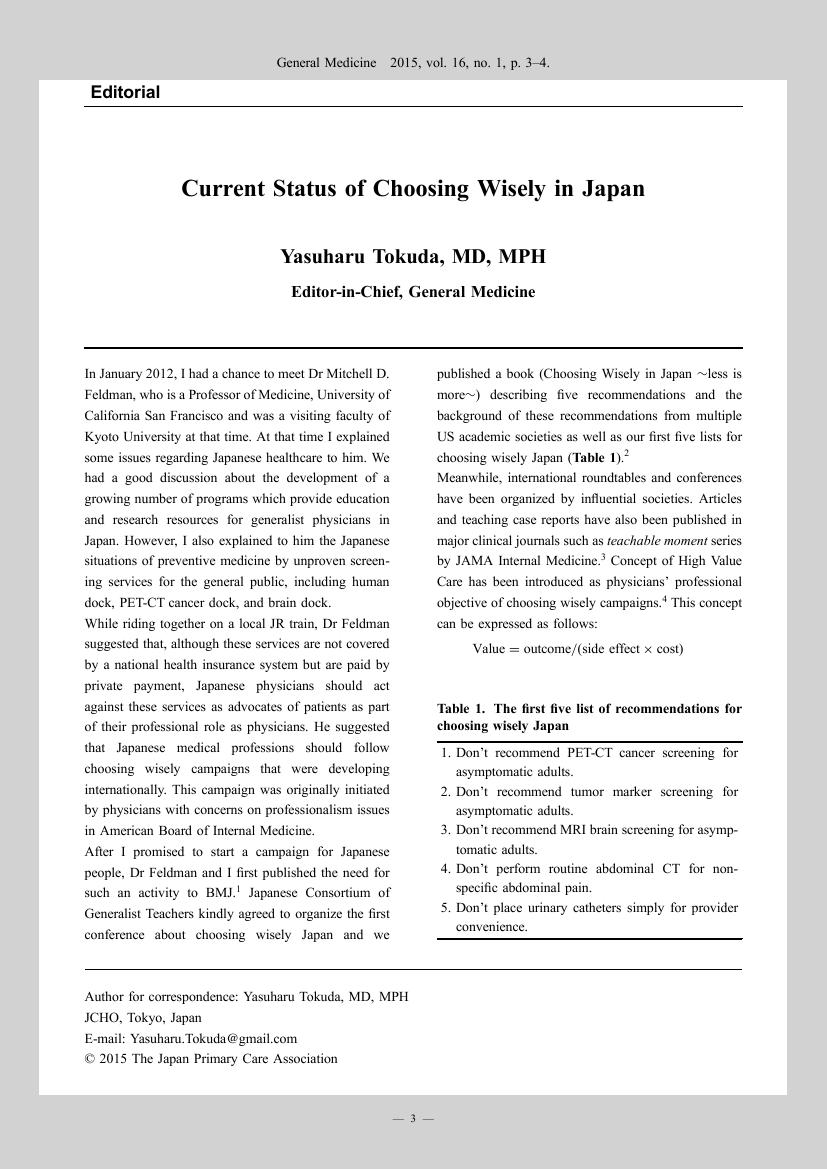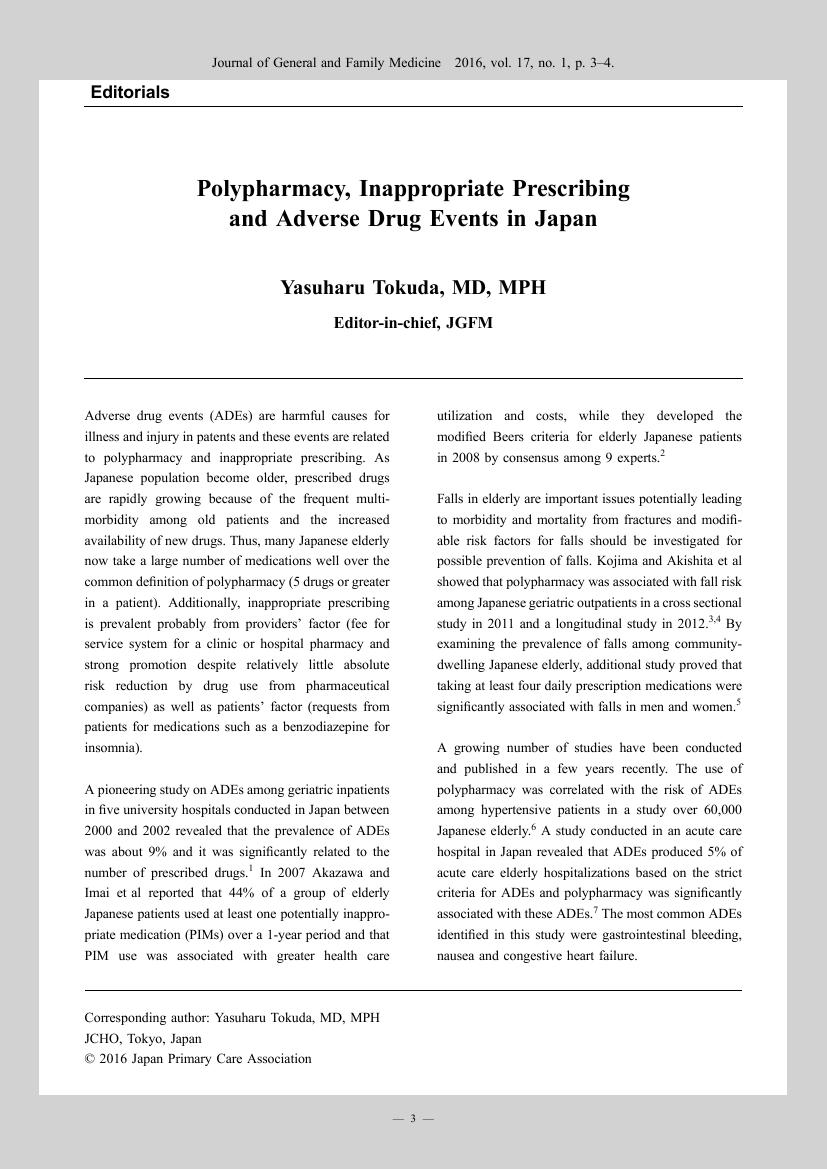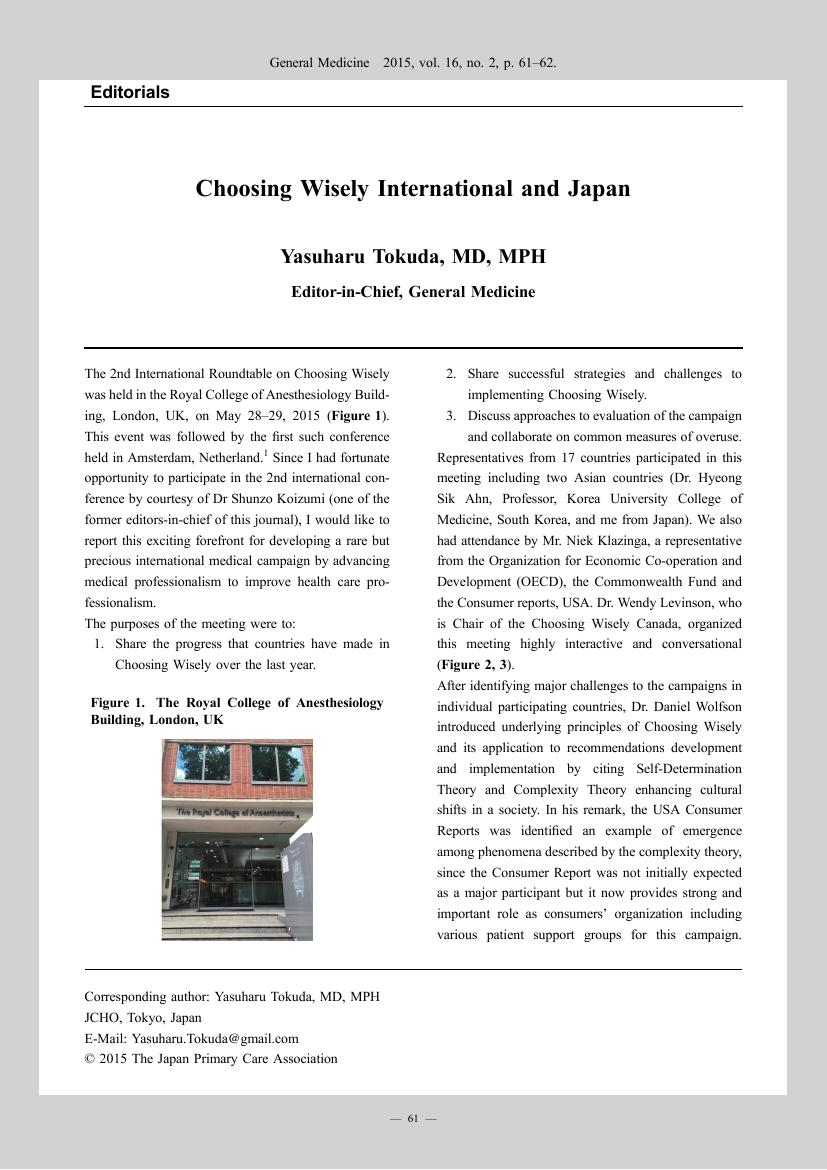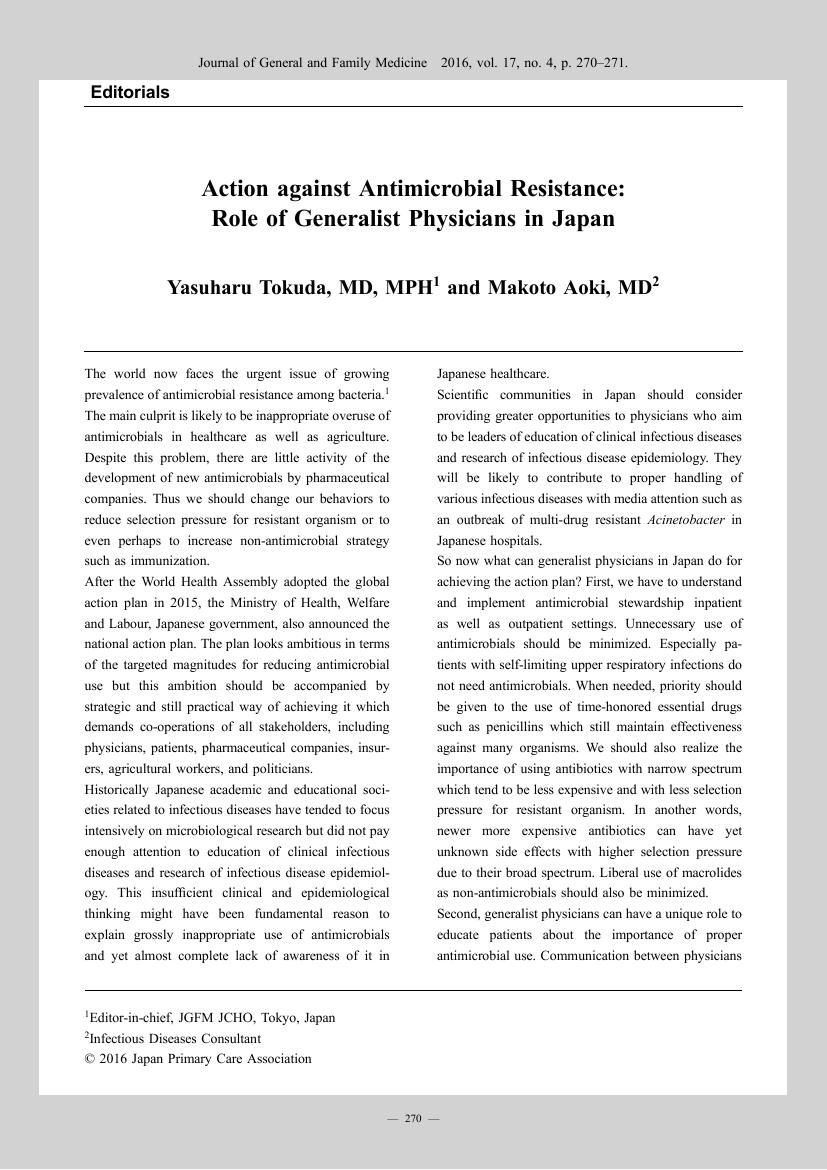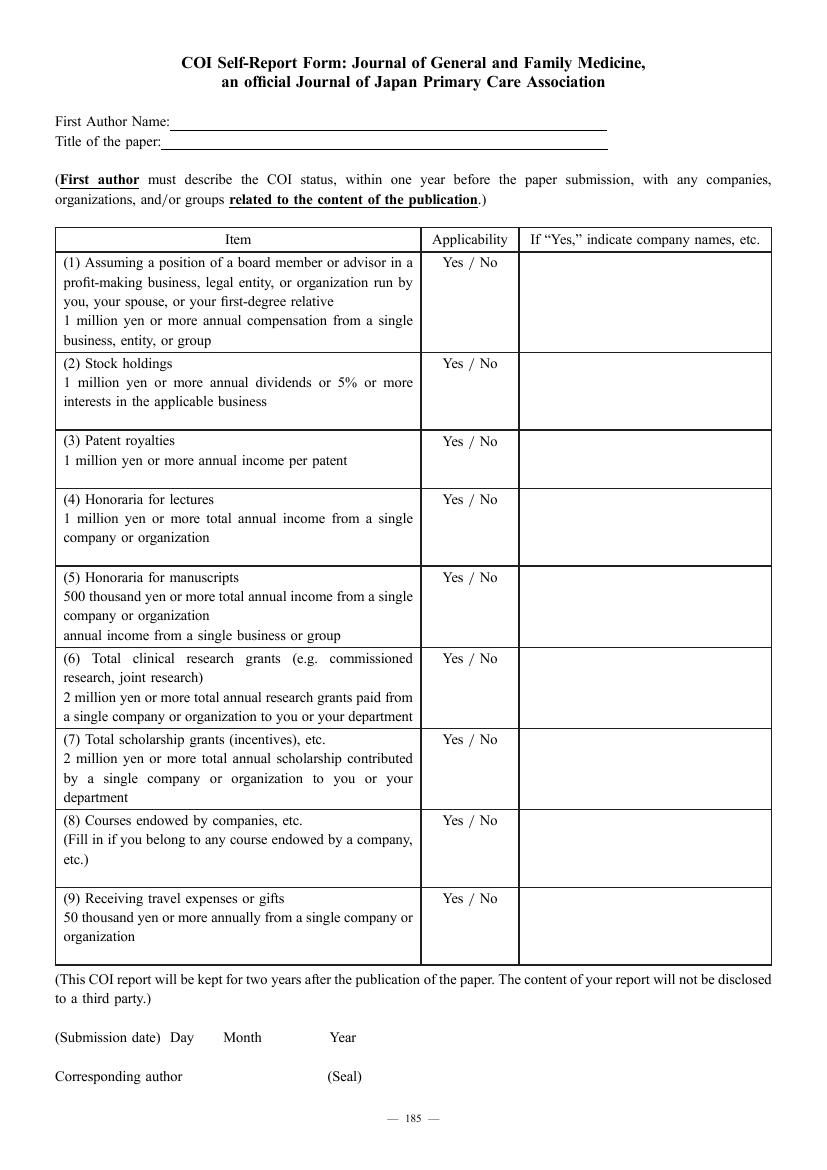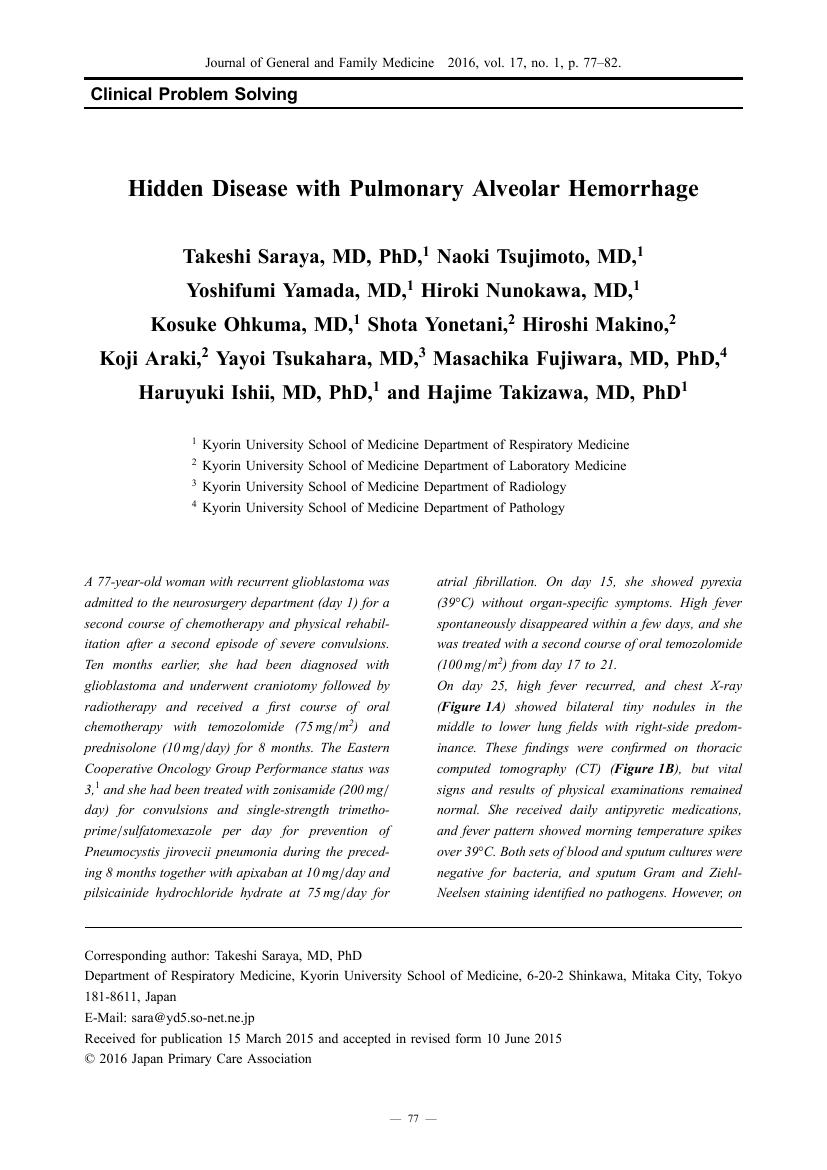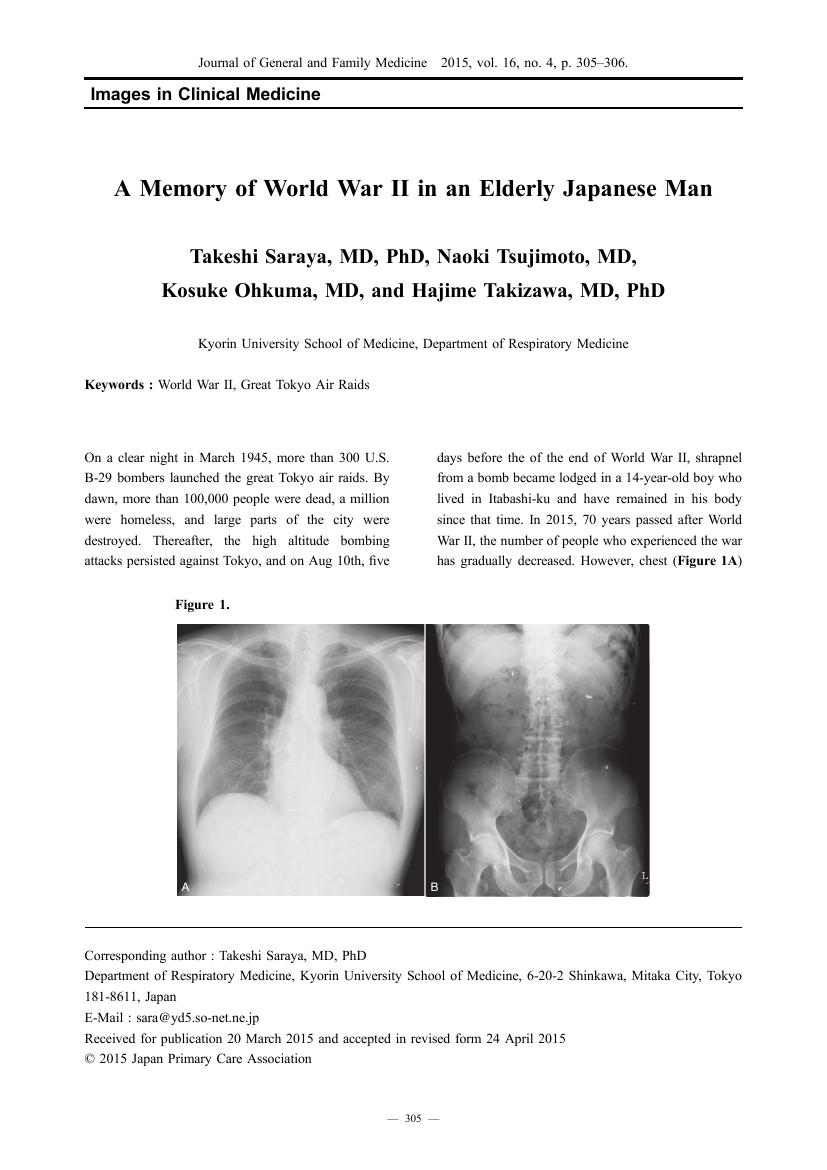60 0 0 0 OA Current Status of Choosing Wisely in Japan
- 著者
- Yasuharu Tokuda
- 出版者
- 日本プライマリ・ケア連合学会
- 雑誌
- General Medicine (ISSN:13460072)
- 巻号頁・発行日
- vol.16, no.1, pp.3-4, 2015-03-20 (Released:2015-03-27)
- 参考文献数
- 6
- 被引用文献数
- 1 7
- 著者
- Kenta Sato
- 出版者
- 日本プライマリ・ケア連合学会
- 雑誌
- Journal of General and Family Medicine (ISSN:21896577)
- 巻号頁・発行日
- vol.17, no.1, pp.90-98, 2016-03-18 (Released:2016-03-25)
- 参考文献数
- 10
- 被引用文献数
- 7
Background: Among the elderly, the rate of complications resulting from malnutrition is high. A mini nutritional assessment short-form (MNA-SF) was confirmed overseas to identify malnutrition and predict clinical outcomes. This study aimed to evaluate the MNA-SF usefulness in Japanese small-sized hospital.Methods: This was a prospective cohort study conducted on hospitalized patients at small-sized hospital, Department of General Internal Medicine which has 30 beds. All consecutive hospitalized patients for 4 months were included. A MNA-SF assessment on admission was implemented as exposure factor. Primary outcomes included death and complications such as infectious disease, organ failure, delirium, falls, diagnosis of malignancy and poor oral intake. Secondary outcomes including days of hospitalization and discharge rate back to home were also measured.Results: 177 patients were analyzed with the MNA-SF assessment. Twenty-three (13%) patients were “normal nutritional status”, 64 (36%) were “at risk” and 90 (51%) were “malnourished”. The mortality rate was 0, 1.4 and 6.9 cases/1000 person-day (incidence ratio 4.9 times), respectively. The complications incidence rate was 0, 18 and 30.1 cases/1000 person-day (incidence ratio 1.7 times), respectively. The number of days in hospital were 11.1, 14.0 and 21.6 days (p < 0.01), respectively. The discharge to home rate was 90.4, 84.4 and 53.3% (p < 0.01), respectively.Conclusions: Among all patients on a Japanese general medicine ward, those with poor nourishment assessed by the MNA-SF showed a high death rate and complication incidence rate. And they are also proved to be difficult to early discharge from the hospital back to the patient’s homes.
8 0 0 0 OA Polypharmacy and Adverse Drug Events Leading to Acute Care Hospitalization in Japanese Elderly
- 著者
- Yoko Fushiki Kensuke Kinoshita Yasuharu Tokuda
- 出版者
- 日本プライマリ・ケア連合学会
- 雑誌
- General Medicine (ISSN:13460072)
- 巻号頁・発行日
- vol.15, no.2, pp.110-116, 2014-12-20 (Released:2014-12-24)
- 参考文献数
- 17
- 被引用文献数
- 13
Background: Elderly patients are considered to be at risk of developing adverse drug events (ADEs) because they tend to receive a greater number of medications. The purpose of our study is to determine the prevalence of ADEs related to polypharmacy and causative admissions of patients in Japanese acute care hospitalization.Methods: In retrospective cohort study, we analyzed 700 consecutive elderly patients admitted to the department of medicine of a Japanese community hospital in 2011. ADEs were defined by World Health Organization–Uppsala Monitoring Centre criteria. Polypharmacy was defined as five or more medications.Results: The mean age was 79.5 years (men, 54%). The mean number of medications was 6.36 +/− 4.15 (maximum, 26). Polypharmacy was observed in 63% of cases. ADEs were identified in 4.9% (95% CI, 3.5–6.7%). The mean numbers of medications among patients with ADEs and those without ADEs were 9.3 +/− 3.4 and 6.2 +/− 4.1, respectively. A greater number of medications was significantly associated with ADEs (p < 0.001). Polypharmacy was identified in 91% of patients with ADEs, while it was noted in 62% of patients without ADEs (p = 0.001). Using logistic regression analysis, polypharmacy was significantly associated with ADEs (Odds ratio 5.89, 95% CI 1.74–19.9). The highest number of ADEs were identified among patients on antiplatelets or anticoagulants (n = 8), followed by benzodiazepines and NSAIDs (n = 4 for both). The most common ADEs were gastrointestinal bleeding, nausea and congestive heart failure.Conclusion: ADEs complicated to about 5% of acute care elderly hospitalizations in Japan. Polypharmacy was significantly associated with these ADEs.
7 0 0 0 OA Factors Associated with Recovery of Activities of Daily Living in Elderly Pneumonia Patients
- 著者
- Ryohei Goto Hiroki Watanabe Naoki Tanaka Takeshige Kanamori Hisako Yanagi
- 出版者
- 日本プライマリ・ケア連合学会
- 雑誌
- General Medicine (ISSN:13460072)
- 巻号頁・発行日
- vol.16, no.2, pp.68-75, 2015-06-20 (Released:2015-06-22)
- 参考文献数
- 29
- 被引用文献数
- 1 12 2
Background: The current study aimed to investigate factors associated with the prognosis of activities of daily living (ADL) in elderly patients with pneumonia who had undergone rehabilitation during their hospitalization.Methods: The study included patients of age ≥65 years who were hospitalized due to pneumonia and had undergone rehabilitation for disuse syndrome at Tsukuba Memorial Hospital. The main outcome was measured using the functional independence measure (FIM) scores to assess ADL. The participants were divided into a high-recovery group (≥80%) and a low-recovery group (<80%) based on the FIM recovery rate score. Further, factors associated with the prognosis of ADL were evaluated using multivariate logistic regression analysis. Basic characteristics, consciousness, usual mode of transportation, FIM score, grip strength, range of motion, orthostatic hypotension, exercise tolerance (6-minutes walking distance), respiratory disorder (Hugh–Jones classification), constipation, malnutrition (mini-nutritional assessment), cognitive (mini-mental state examination), depression (geriatric depression scale), balance (functional balance scale), urinary incontinence, and pressure ulcers were included as the evaluation items.Results: Among the 51 elderly patients with pneumonia (average age ± SD; 82.0 ± 11.3), 34 patients were classified in the high-recovery group and 17 in the low-recovery group. In multivariate logistic regression analysis, it was revealed that the number of days from the onset until the initiation of rehabilitation (days of inactivity) and nutritional status were factors associated with a high-recovery FIM score.Conclusions: The study results suggest that days of inactivity and early management of nutritional status after hospitalization are important for elderly patients with pneumonia to return to their ADL.
- 著者
- Kenichiro Yaita Hideki Ohshima Makiko Hayashi Masayuki Nakamura Shin-ichiro Ueda Yoshiro Sakai Kenji Masunaga Koichi Ohshima Hiroshi Watanabe
- 出版者
- 日本プライマリ・ケア連合学会
- 雑誌
- Journal of General and Family Medicine (ISSN:21896577)
- 巻号頁・発行日
- vol.17, no.2, pp.176-178, 2016-06-18 (Released:2016-06-18)
- 参考文献数
- 7
- 著者
- Yasuharu Tokuda
- 出版者
- 日本プライマリ・ケア連合学会
- 雑誌
- Journal of General and Family Medicine (ISSN:21896577)
- 巻号頁・発行日
- vol.17, no.1, pp.3-4, 2016-03-18 (Released:2016-03-25)
- 参考文献数
- 11
- 被引用文献数
- 4
5 0 0 0 OA Choosing Wisely International and Japan
- 著者
- Yasuharu Tokuda
- 出版者
- 日本プライマリ・ケア連合学会
- 雑誌
- General Medicine (ISSN:13460072)
- 巻号頁・発行日
- vol.16, no.2, pp.61-62, 2015-06-20 (Released:2015-06-22)
- 参考文献数
- 2
- 被引用文献数
- 1
- 著者
- Kenichiro Yaita Yohei Sakamoto Kazuhiko Nakaharai Yukihiro Yoshimura Natsuo Tachikawa
- 出版者
- 日本プライマリ・ケア連合学会
- 雑誌
- General Medicine (ISSN:13460072)
- 巻号頁・発行日
- vol.15, no.1, pp.68-71, 2014-06-20 (Released:2014-06-27)
- 参考文献数
- 12
- 被引用文献数
- 1 2
A 58-year-old female was admitted due to severe sepsis and multi-organ failure with a fulminant purpuric rash. Meropenem, vancomycin and levofloxacin were administered, although no focus of infection was detected. However, computed tomography revealed a profoundly hypoplastic spleen, and a blood smear detected Howell-Jolly bodies. Blood cultures grew Streptococcus pneumoniae (serotype 22F) three hours after admission. The patient was finally diagnosed as overwhelming pneumococcal sepsis with hyposplenism precipitated by splenic hypoplasia. Clinicians should pay attention to the splenic size and Howell-Jolly bodies in cases of sepsis of unknown origin.
- 著者
- Kenzo Tanaka Koichiro Gibo Hiroko Watase Masaki Oohashi Carlos A. Camargo Kohei Hasegawa on behalf of the Japanese Emergency Medicine Network Investigators
- 出版者
- 日本プライマリ・ケア連合学会
- 雑誌
- Journal of General and Family Medicine (ISSN:21896577)
- 巻号頁・発行日
- vol.16, no.4, pp.281-287, 2015-12-20 (Released:2015-12-25)
- 参考文献数
- 14
Background: Little is known about the extent that acute asthma is inappropriately treated with antibiotics in Japanese emergency departments (EDs).Objectives: We examined the proportion and predictors of inappropriate antibiotic use for adults with acute asthma in the Japanese EDs.Methods: We conducted a chart review study in 23 Japanese EDs. Subjects were ED patients aged 18 to 54 years with acute asthma between 2009 and 2011. To examine predictors of inappropriate antibiotic use, we performed multi-level logistic regression analysis at both the patient- and ED-level modeling EDs as a random variable.Results: Among 1380 patients in the overall study, the analytic cohort comprised 1311 patients. Overall, antibiotics were inappropriately prescribed for 4.4% (95% confidence interval [CI], 3.4%–5.7%). In the multi-level logistic regression analysis, higher annual ED asthma visit volume was significantly associated with a lower proportion of inappropriate antibiotic use (odds ratio per 100-visit increase, 0.3 ; 95%CI, 0.2–0.6).Conclusions: In this large multicenter study in Japan, we found that approximately 4% of ED patients with acute asthma were inappropriately treated with antibiotics. We also demonstrated that the inappropriate use of antibiotics largely differed across the EDs and was less common in EDs with a more annual ED asthma visits. Organized knowledge translation initiatives are warranted to address this gap in emergency asthma care.
- 著者
- Yasuharu Tokuda Makoto Aoki
- 出版者
- 日本プライマリ・ケア連合学会
- 雑誌
- Journal of General and Family Medicine (ISSN:21896577)
- 巻号頁・発行日
- vol.17, no.4, pp.270-271, 2016-12-18 (Released:2016-12-27)
- 参考文献数
- 1
- 著者
- Kentaro Iwata Wataru Igarashi Midori Honjo Takashi Nishimoto Kyoko Shinya Akiko Makino Kazuo Mitani Yoshiko Tatsumi Hiroyuki Ninomiya Kumi Higasa Seiichiro Usuki Hiroki Kagawa Daisuke Uchida Kohei Takimoto Rei Suganaga Hiroo Matsuo Yuichiro Oba Mami Horigome Hideaki Oka Goh Ohji Yasuhisa Abe Hiroyuki Yoshida Shohiro Kinoshita Midori Hirai
- 出版者
- 日本プライマリ・ケア連合学会
- 雑誌
- General Medicine (ISSN:13460072)
- 巻号頁・発行日
- vol.14, no.1, pp.13-22, 2013 (Released:2013-07-05)
- 参考文献数
- 34
- 被引用文献数
- 3
Background: Gingyo-gedoku-san (GGGS) is an herbal medicine approved for upper respiratory infections in Japan. We conducted an open-label, multi-center, prospective trial, comparing GGGS with oseltamivir in patients with influenza and influenza-like illness (ILI) as a pilot study.Methods: Subjects were healthy persons aged between 16 and 40, and were enrolled from January 12, 2010 to March 24, 2011. Fifteen patients were enrolled in this trial (8 and 7 for GGGS and oseltamivir, respectively). RT-PCR was positive for pandemic influenza A (H1N1) in 10 patients. The patients were provided with either GGGS or oseltamivir for 5 days. The primary outcome was mortality and/or hospitalization 7 days after the initial diagnosis. Body temperature and other clinical characteristics were also evaluated.Results: All patients recovered from illness without complication or hospitalization. The mean time to resolve symptoms for the GGGS and oseltamivir groups was 3.9 days and 3.3 days, respectively (p=0.43). The GGGS group appeared to have a smaller symptom score AUC than the oseltamivir group, (p=0.26). Time to recover activity level appeared to be shorter in the GGGS group (p=0.10), with shorter time to recover health status (p=0.02). Sub-group analysis on patients with positive PCR showed similar results between the two groups.Conclusion: GGGS was associated with symptom improvements resembling oseltamivir for both influenza and ILI. Randomized controlled trials involving larger sample sizes are needed to confirm these results.
- 著者
- Yuji Nishizaki Shinichiro Yamagami Hitoshi Sasano Eiryu Sai Kazuhisa Takamura Toshiki Nakahara Yoshiaki Furukawa Hiroyuki Daida
- 出版者
- 日本プライマリ・ケア連合学会
- 雑誌
- General Medicine (ISSN:13460072)
- 巻号頁・発行日
- vol.16, no.1, pp.41-44, 2015-03-20 (Released:2015-03-27)
- 参考文献数
- 6
A 91 year-old male who was orally receiving dabigatran and digitalis for chronic arterial fibrillation was hospitalized for cerebral infarction (CI). The complications of anemia due to gastrointestinal bleeding and the development of renal failure were also found, which enhanced the effect of digitalis. This enhanced drug action induced bradycardia and hypotension. The hypotension was improved by implanting a temporary pacemaker, and the neurological abnormal findings also disappeared with the improved blood pressure. In many cases, dabigatran is efficient in preventing CI, but in our case it in fact triggered a CI hemodynamically due to bradycardia and hypotension with gastrointestinal bleeding.
- 著者
- 岩田 健太郎
- 出版者
- 日本プライマリ・ケア連合学会
- 雑誌
- プライマリ・ケア : 実践誌 (ISSN:24323098)
- 巻号頁・発行日
- vol.4, no.3, pp.37-40, 2019
- 出版者
- 日本プライマリ・ケア連合学会
- 雑誌
- Journal of General and Family Medicine (ISSN:21896577)
- 巻号頁・発行日
- vol.17, no.2, pp.185-185, 2016-06-18 (Released:2016-06-18)
- 著者
- Toshio Naito Keiko Kume Kazunori Mitsuhashi Tetsu Okumura Hiroshi Isonuma Takashi Dambara Koichi Suda Yasuo Hayashida
- 出版者
- 日本プライマリ・ケア連合学会
- 雑誌
- General Medicine (ISSN:13460072)
- 巻号頁・発行日
- vol.7, no.1, pp.21-24, 2006 (Released:2010-06-08)
- 参考文献数
- 16
- 被引用文献数
- 1
We recently encountered a case of fatal pneumococcal infection in a previously healthy 19-year-old female. She had no history of splenectomy, but on autopsy she was found to have hyposplenism. It has been widely reported that life-threatening pneumococcal infection can occur after splenectomy, though cases of hyposplenic or asplenic adults, without a history of splenectomy, are very rare. We report this case and review the literature dealing with 6 similar cases.
- 著者
- Takeshi Saraya Naoki Tsujimoto Yoshifumi Yamada Hiroki Nunokawa Kosuke Ohkuma Shota Yonetani Hiroshi Makino Koji Araki Yayoi Tsukahara Masachika Fujiwara Haruyuki Ishii Hajime Takizawa
- 出版者
- 日本プライマリ・ケア連合学会
- 雑誌
- Journal of General and Family Medicine (ISSN:21896577)
- 巻号頁・発行日
- vol.17, no.1, pp.77-82, 2016-03-18 (Released:2016-03-25)
- 参考文献数
- 14
- 被引用文献数
- 1
- 著者
- Takuma Kimura Teruhiko Imanaga Makoto Matsuzaki Tohru Akahoshi
- 出版者
- 日本プライマリ・ケア連合学会
- 雑誌
- Journal of General and Family Medicine (ISSN:21896577)
- 巻号頁・発行日
- vol.16, no.4, pp.271-280, 2015-12-20 (Released:2015-12-25)
- 参考文献数
- 15
- 被引用文献数
- 1
Background: In home medical care settings, some patients’ families always attend provider visits, and others only do so when needed. The clinical background behind this difference is not well defined.Methods: A cross-sectional mail survey of families of Japanese patients who had previously received home medical care, asking whether the family had always been present the patient during home healthcare visits and their reasons. Survey results were analyzed with a multivariable adjusted logistic regression model based on the explanatory variables, for aspects related to the family’s attendance at provider visits.Results: Among the 271 families contacted, 190 families who finally met the selection criteria were divided into two groups : 155 families (81.6%) who had always been present with the patient ; and 35 families (18.4%) who had done so only when needed. Constant attendance by family members was significantly associated with the level of care required (odds ratio [OR] : 1.40, 95% confidence interval [CI] : 1.05–1.89, p = 0.02) and age of the primary caregiver (OR : 1.05, 95% CI : 1.02–1.09, p = 0.03). However, when the family had difficulty communicating with the provider owing to the patient’s presence, families tended not to be present during visits by providers (OR : 0.41, 95% CI : 0.17–1.02, p = 0.06).Conclusions: In home medical care settings, visiting healthcare providers should bear in mind that if the family is not always present with the patient, there is a possibility that the family is experiencing difficulty communicating with the provider owing to the patient’s presence.
- 著者
- Takeshi Saraya Naoki Tsujimoto Kosuke Ohkuma Hajime Takizawa
- 出版者
- 日本プライマリ・ケア連合学会
- 雑誌
- Journal of General and Family Medicine (ISSN:21896577)
- 巻号頁・発行日
- vol.16, no.4, pp.305-306, 2015-12-20 (Released:2015-12-25)
- 参考文献数
- 1
- 著者
- Yosuke Sasaki Satoru Manda Takahiro Sato Tadashi Maeda Taito Miyazaki Kazushige Nakanishi Yoshihisa Urita
- 出版者
- 日本プライマリ・ケア連合学会
- 雑誌
- Journal of General and Family Medicine (ISSN:21896577)
- 巻号頁・発行日
- vol.16, no.3, pp.204-207, 2015-09-20 (Released:2015-10-30)
- 参考文献数
- 15
- 被引用文献数
- 3
Chikungunya virus infection (CVI) typically manifests via a “two-phase” presentation: most patients develop acute fever and some patients subsequently develop arthralgia that can persist for years. Many patients visit clinics during the second phase, for relief of the arthralgia, but not during the acute febrile phase. We report a 25-year-old Japanese man infected with CVI in Jamaica who presented with chronic disabling peripheral-dominant symmetric polyarthralgia without fever, which affected the neck, knees, elbows, wrists, and fingers. Given the recent emergence of dengue fever in Japan, clinicians should consider CVI as a differential diagnosis of dengue fever when examining travelers complaining of persistent arthralgia, regardless of their countries of origin.
1 0 0 0 OA A Case of Sore Throat and Fever
- 著者
- Masayuki Amano Taro Shimizu
- 出版者
- 日本プライマリ・ケア連合学会
- 雑誌
- General Medicine (ISSN:13460072)
- 巻号頁・発行日
- vol.16, no.2, pp.63-67, 2015-06-20 (Released:2015-06-22)
- 参考文献数
- 11
